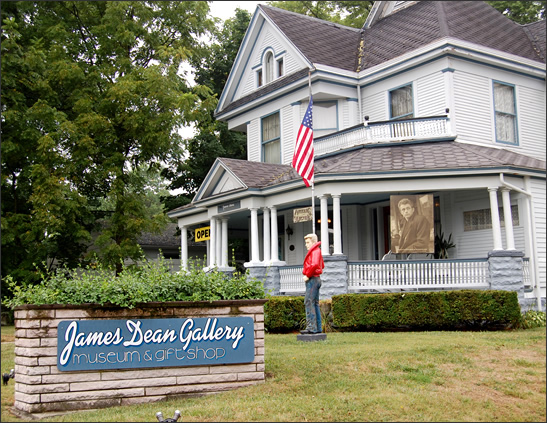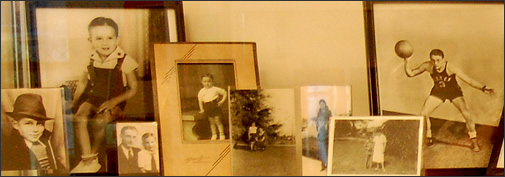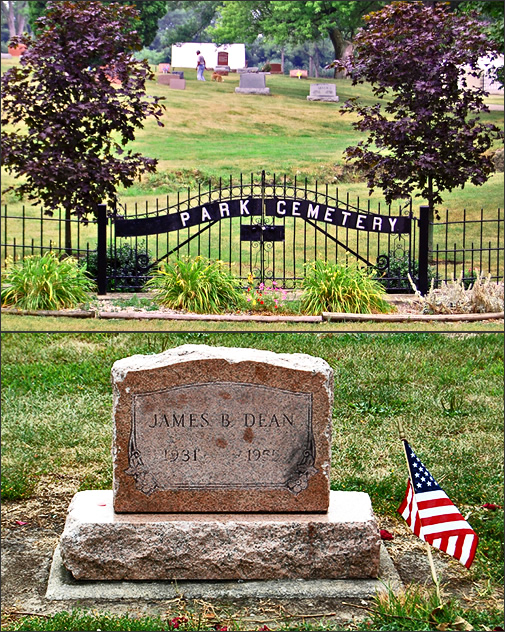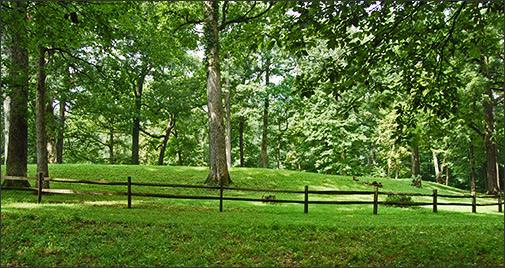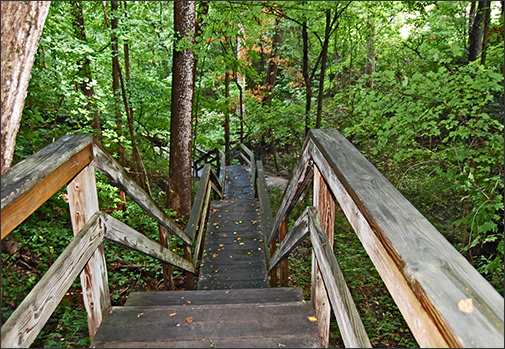|
An icon of American pop culture strikes a pose in Fairmount, Indiana
Photos by Ron Fritze ~ August 2011
Of A Dean and Many Mounds:
Two Hoosier Excursions
By Ron Fritze from Athens, Alabama
Posted on September 14, 2011
One thing I have learned is that no matter where you live, there is a lot of history in your own backyard. That might not be true for someone living in Antarctica, but even in that situation, you would have a whole bunch of natural history just outside the doorway of your warm little berth in the icy research outpost.
As for me, I grew up in Fort Wayne, Indiana, where there was a lot to learn and a lot to see. There are, however, lots of Hoosier things I never experienced or checked out. Now, years later, I try to remedy the gaps in my Hoosier experience whenever I’m able to go back home to Indiana. Recently, while driving through my old stomping grounds on the way back to Alabama, I found the time to stop and see a couple of interesting sites.
My first stop was Fairmount, about five miles west of I-69 in the east-central region of the state. For those up on their Fifties nostalgia, they will already know that Fairmount is where James Dean grew up.
A Thoroughly Normal Upbringing
(And Not in Iowa, Mr. Katz)
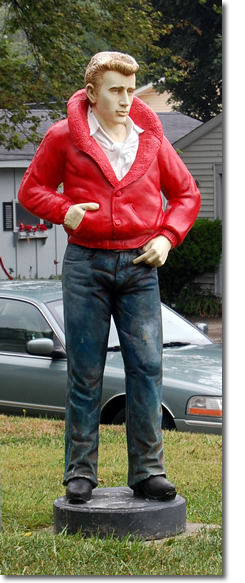
James Dean is an American icon who made a big splash during a painfully short career. He was born in Marion, Indiana, on 8 February 1931. After his mother died when he was nine years old, James was taken in by his aunt and uncle, Ortense and Marcus Winslow, who raised him in Fairmount. Incredibly, the generally reliable Film Encyclopedia by Ephraim Katz states incorrectly that James was raised in Iowa! Katz, a filmmaker and scholar of the cinema, was a resident of New York City — and I have it on reliable information that some residents of the Big Apple are geographically challenged when the location of a particular inquiry carries them a few miles west of the Hudson. Apparently, Mr. Katz belonged to that group.
Dean’s upbringing in Indiana was thoroughly normal. At Fairmount High School he was an average student academically, but he excelled as a basketball player, a highly regarded accomplishment among Hoosiers. He also did quite well in track (athletics for those of you in the UK). James also demonstrated a theatrical bent, participating in the debate club and acting in plays.
Graduating from high school in 1949, he joined his father living in California. James attended Santa Monica City College and UCLA, studying theater arts. Anxious to become an actor, he won a part in a Pepsi commercial, earning thirty dollars. He also landed several bit parts in four undistinguished movies.
Kazan Sends Dean East of Eden
In 1951 the ambitious young actor moved to New York City, where got work on a number of television shows and some Broadway plays. Elia Kazan spotted Dean in his second Broadway play, The Immortalist, in 1954. The influential director sent Dean to Hollywood to screen test for a leading role in East of Eden. James got the part, his first film role, and his performance earned him an Academy Award nomination.
Dean’s next role came as star of Rebel Without A Cause directed by Nicholas Ray. Although his performance in the 1955 classic did not garner an Academy Award or even a nomination, the image he projected as the character Jim Stark transformed James Dean into icon of youth rebellion. For an insightful and amusing account of 1950s film culture, including a great discussion of Rebel Without A Cause, see Peter Biskind, Seeing is Believing: How Hollywood Taught Us to Stop Worrying and Love the Fifites.
James’s third and final film, Giant, put him onscreen with established stars Rock Hudson and Elizabeth Taylor. George Stevens directed the film and won an Academy Award for it. Dean received an Academy Award nomination for Best Actor in a Leading Role.
Trust Me. It's Been Said Before.
Sadly, James Dean died young. He is credited with saying, “Live fast, die young and have a beautiful looking corpse,” but that phrase actually came from an obscure 1949 movie, Knock On Any Door. Dean did say, "Dream as if you'll live forever. Live as if you'll die today," but quotes along those lines have been made by others, including Gandhi, and express a sentiment that goes way back. Edmund of Abingdon (d. 1240) gave similar advice to his students at Oxford: "Study as if you were to live forever; live as if you were to die tomorrow."
Still, Dean was a thoughtful person. He also liked fast cars and racing. On 30 September 1955, he was killed in an automobile accident while driving his new Porsche from Hollywood to Salinas for a race. At that point, only East of Eden had appeared in theaters. Rebel Without A Cause was released one week after his death. Giant appeared in 1956.
Dying young and then appearing on the silver screen a few days after his burial as an iconic figure of youthful rebellion became an act of cultural transfiguration, changing the flesh-and-blood, twenty-four-year-old Dean into an instant cult hero of enduring power. And — Elvis has left the building! — there were even rumors that the young actor was not really dead.
James Dean has remained a cult figure of popular culture ever since. The scene at Fairmount today bespeaks the staying power of his identity.
Photos from Dean's childhood on display at the Gallery
A Friendly Man and a Friendly Dog
Greet Visitors at the Gallery.
Getting off I-69, I drove down a road past farmland to get to Fairmount. The drive reminded me of how pretty and verdant Indiana really is. In town, I followed the signs to the James Dean Gallery on Main Street. It is an old house in a residential neighborhood. Admission is free, and the friendly man running the place was eager to tell the story of the gallery’s namesake. He also gave me a helpful map of all the James Dean sites in town and a bit out of town.
The museum guide has adopted a very friendly rescue dog named Callie, who served as a friendly greeter. Giving the pup a few pets made us fast friends, and she was all over me when she was not nestling on my feet and presenting her tummy for a rub. Fortunately for the owner, Twylia was not with me as she would have engaged in a dognapping. Callie is a very sweet dog. As for the museum, it is full of James Dean memorabilia. It is worth a look.
My next stop was Park Cemetery to see James Dean’s grave. The marker is surprisingly modest, although someone had placed an American flag next to the headstone. So, if you are driving along I-69 in Indiana one future day, I recommend a stop in Fairmount. They are hosting the 36th Annual James Dean Festival next week, 22-25 September. Looks like fun.
From the Rebel without a Cause
To the 'Great Mound' with a Purpose
Getting back on I-69, I drove south to Anderson. Destination: Mounds State Park. I am an Indian Mound junkie, but I had not ever visited this park, even though it stands in the backyard of my childhood. Time had come to correct that omission.
Admission is five bucks a car and well worth it. My first stop was the Visitor Center, which features some nice displays. Of the ten mounds on the grounds, the premier site is the “Great Mound,” the largest mound in Indiana, a circular structure that was used for astronomical and calendrical purposes.
The 'Great Mound' is about 2,000 years old
These mounds are unique in that they appear to represent a transitional phase between the earlier Adena culture of mound builders and the succeeding and more widespread Hopewell culture. Dating for the mounds vary. The pamphlet from Mounds State Park suggests a date of 150 BC, but another book suggests a possible date of 10-40 AD. Either way, the mounds are 2,000 years old.
I followed “Path No. 2” to the Great Mound. The path is rated as rugged, but in fact, for much of the way, you walk along a boardwalk through a ravine with a little stream flowing through it. The path requires the walker to go down some stairs and then climb back up. It had rained the night before my visit, so the oppressive heat that had been afflicting much of the United States moderated somewhat. I almost slipped and fell on the boardwalk as it was slick from moisture. Down in the ravine, the air was comfortable in the shade, although still quite humid. You could see mist rising from the damp ground.
'Path No. 2' descends into the ravine
The Great Mound is located in an area cleared of undergrowth. It is not a complete circle. There is a gap in the wall of the mound that served as an entrance for various religious rituals. The mound also has a wood-rail fence around it. Apparently you are not supposed to walk on it. I didn’t. The park’s brochure states that the Great Mound is about a quarter of a mile in circumference. That is about right as I walked the perimeter and counted my paces at 428. There are two smaller mounds next to the Great Mound. If they were not marked, most people, including me, would just think they were part of the natural landscape.
Mounds State Park is a fine small park. It has six hiking paths which come to six miles altogether and range from easy to rugged. Path No. 1 also goes to the Great Mound, but it is an easier walk. The park has a lot of interesting natural history. There are facilities for camping, but my desire to go camping went away a long time ago, although I wish I would have had more time to walk the paths of Mounds State Park.
Like the James Dean sites in Fairmount, the mounds are well worth stopping to see. Also, as far as I know, the mounds of Mound State Park have not been subjected to the indignity of being associated with any crackpot theories about wandering aliens, ancient Egyptians, Welsh Indians, or Chinese seafarers arriving in Indiana in the long ago to raise-up mounds for the purpose of anything from launch pads to forts. And that is not a bad thing.

Click on the black panther to read about Ron Fritze's latest book,
Invented Knowledge: False History, Fake Science, and Pseudo-religions. |



